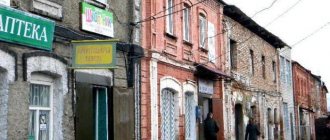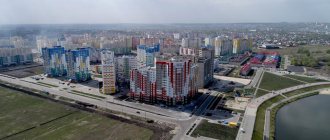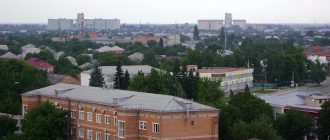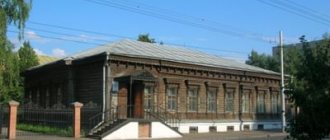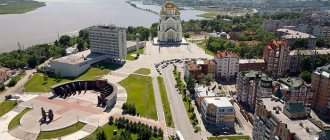The city of Tynda, Amur region:
Tynda city
— the administrative center of the Tyndinsky district of the Amur region. Sometimes the city is called the “capital of BAM”. The status of a city was received in November 1975, before that - in 1907 the village of Tyndinsky. The actual number of residents is about 36 thousand people.
The city is located on the Tynda River (Amur basin), 839 km from Blagoveshchensk, about 6.7 thousand kilometers by rail and about 5.1 thousand kilometers by air. Located in the eastern part, at the confluence of the Getkana River and the Tynda River, at an altitude of more than 500 m above sea level. A large transport hub in the north-west of the Amur region, where the Taishet-Urgal and Bamovskaya-Berkakit lines intersect. Temperate geographical zone. The following trees grow in the city: willow, birch, conifers, poplar, rowan, and bird cherry. The main part of the vegetation is taiga.
Tynda is the northernmost and youngest city of the Amur region.
Education in the city of
Tynda.
After the merger of some educational institutions (Gymnasium No. 2 merged with school No. 1 and No. 5), the city was left with 4 schools and private gymnasium No. 1, which is recognized as the richest and most expensive gymnasium in the region.
The very first school No. 1, now No. 7 in Tynda, was located on the street. 2nd Pyatiletka, on this site there is now school No. 2, now st. Sports.
In Tynda there is a railway transport technical school and a branch of the Far Eastern State Transport University (FESGUPS), united in 2007 into the Baikal-Amur Institute - a branch of the State Educational Institution of Higher Professional Education "Far Eastern State Transport University" in Tynda. There are also branches of other educational institutions in the city.
Economy of the city of Tynda:
At the beginning of January 2010, Tynda was included in the list of single-industry towns in Russia
because of one city-forming enterprise - the railway.
OJSC "Bamstroymekhanizatsiya"
the largest company in the Far East specializing in the construction of railways and highways. Annual turnover is more than 10 billion rubles. The main sponsor of many projects.
LPK Tynda-les
- the largest timber industry complex in Russia.
Mostostroy - 10
is the largest enterprise specializing in the construction of railway lines and bridges.
There are many railway transport enterprises in the city:
Tynda branch of the Far Eastern Railway (planned to be disbanded on July 1, 2010 due to the transition to a non-departmental structure), locomotive and carriage depot, line enterprises.
There are permafrost and hydrometeorological stations. The Tynda geological prospecting expedition is located not far from the city.
The city's public transport is represented by buses, minibuses and taxis.
Tynda is a transport hub where the M56 Lena federal highway and the BAM and AYAM railway lines intersect. The only one in the Amur region runs to Blagoveshchensk.
Bear region
A settlement existed here since the 20s of the 20th century: first just as a winter hut, where gold miners and hunters lived, then as a full-fledged village, called Tyndinsky. The name comes from the Evenks, the indigenous inhabitants of the north of the region.
The project for the construction of the Baikal-Amur Mainline appeared in the 1930s of the last century - the country’s leadership decided to develop the untrodden region and build a railway between the village of Urusha in the Trans-Baikal Territory and the village of Perm, now Komsomolsk-on-Amur. It was assumed that construction of the road would begin in 1933 and be completed two years later, but in the end it took 49 years to complete the project.
But let's not get ahead of ourselves. All BAM plans existed on paper - where the railway was supposed to pass, the land was practically undeveloped. It was not possible to recruit free builders in sufficient numbers, and the OGPU was brought in to resolve the issue. In the north of the Amur region, the Baikal-Amur correctional camp, infamously known as BAMlag, was created. Arriving exiles were met by taiga, permafrost and 50-degree frosts - neither nature nor the Soviet government gave people any relief.
Nikolay Gusev, Yandex
However, with the outbreak of the Great Patriotic War, the construction of the highway had to be frozen. At that time, the railway tracks were laid in only two sections, from which the rails and bridge trusses were immediately removed, and all this was sent to the west of the country, to the sites of major military operations. For example, the construction of the railway from Stalingrad to Sviyazhsk, which ultimately influenced the outcome of the Battle of Stalingrad.
bredford68, Yandex, Shepelev Sergey
The BAM project froze for an indefinite period of time - after the war there was no time for it. And the construction of the Baikal-Amur Mainline was discussed again only in the mid-60s. At that time, the village of Tyndinsky was a completely peaceful and calm settlement. Yes, bearish country. Yes, it’s freezing and far from civilization. But the people here were strong, accustomed to everything, and it was not for nothing that they were exiles. And those who were not strong had to become so.
kor70wet, Yandex
At the end of the 60s, when pieces of paper with the word BAM rustled from the archives in Moscow, the village had its own music school - a sign of the coming civilization. Many of the exiles were educated and intelligent people, and the younger generation adopted from their parents the desire for spiritual development.
At first, the children studied in a small log hut, in the middle of which there was a huge stove, a real salvation. The frosts stayed at 50 degrees, and the guys who came to classes first warmed their fingers in the stove “oven”, or, as it was called then, “Kakhovka”.
Tynda's story:
In the 1850s, mining engineer Pavel Anosov discovered the first gold deposits in rivers flowing near the present city of Tynda[4].
According to archival data, in 1907-1908, the Tyndinsky resettlement area was formed on the site of Tynda. The site was designed for 108 male migrants, but was not populated. In 1917, Tynda became a transshipment point for gold miners, and in the same year there was the first mention of it.
According to the 1924 census, 180 people lived in the village.
In 1931, residents from European and border regions of the Far East were sent to Tyndinsky. Most of the residents remained in the village.
The settlement was remembered already in 1937, when a railway line was needed to develop the Far East. Already on November 1 of the same year, the first steam locomotive set off on the Bam-Tynda branch.
According to the population census conducted in 1939, about four thousand people lived in Tynda. For the Far Eastern hinterland of the Stalin years, this is a lot.
On November 15, 1975, the village became the city of Tynda. BAM builders from various republics of the USSR settled in a new city, designated the “capital” of BAM.
In 1985, the foundation of a future shoe factory was laid, which remained the foundation, and a new meat and dairy plant was opened. In 1986, the supply of food and raw materials to the city was significantly cut. The air was literally cut off to the city. Freight transportation along the BAM has decreased tenfold. The highway was hardly used. But despite this, the city developed: according to the 1989 census, 62.3 thousand people lived in the city. The population peaked in January 1991, with 65,000 people living in the city, according to census data.
But by the end of the 1990s, there were about 47 thousand people in the city. A sharp outflow of population began. The city was declared unpromising, the number of jobs was declining. Construction of residential buildings throughout the city was stopped. The government declared the highway unprofitable.
In 1997, BAM was disbanded, its western section was attached to the East Siberian Railway, and the eastern section, as part of the Tyndinsky and Urgal branches, was connected to the Far Eastern. The “era of stagnation” begins in the city for almost fifteen years.
By 2012, the waste treatment plant should be put into permanent operation. The emergence of these factories will lead to the introduction of new specialties in the city's educational institutions and possibly to an influx of population.
Climate[edit]
Tynda has a subarctic climate ( Köppen climate classification Dwc
) with very cold, rather dry winters and warm, very rainy summers.
| Climate data for Tynda | |||||||||||||
| Month | Jan | Feb | Mar | Apr | May | Jun | Jul | Aug | Sep | October | But I | December | Year |
| Record high °C (°F) | 0,0 (32,0) | -0,5 (31,1) | 12,4 (54,3) | 25,3 (77,5) | 34,0 (93,2) | 35,2 (95,4) | 37,2 (99,0) | 34,4 (93,9) | 28,2 (82,8) | 20,2 (68,4) | 6,2 (43,2) | 0,0 (32,0) | 37,2 (99,0) |
| Average high °C (°F) | -23,0 (-9,4) | -16,0 (3,2) | -6,1 (21,0) | 4,1 (39,4) | 13,9 (57,0) | 22,1 (71,8) | 24,3 (75,7) | 21,5 (70,7) | 13,7 (56,7) | 1,4 (34,5) | -13,7 (7,3) | -23,4 (-10,1) | 1,6 (34,9) |
| Daily average °C (°F) | -29,0 (-20,2) | -24,0 (-11,2) | -14,8 (5,4) | -3,0 (26,6) | 6,6 (43,9) | 14,4 (57,9) | 17,2 (63,0) | 14,3 (57,7) | 6,7 (44,1) | -5,6 (21,9) | -20,2 (-4,4) | -28,7 (-19,7) | -5,5 (22,1) |
| Average low °C (°F) | -35,1 (-31,2) | -32,0 (-25,6) | -23,5 (-10,3) | -10,1 (13,8) | -0,7 (30,7) | 6,6 (43,9) | 10,0 (50,0) | 7,1 (44,8) | -0,4 (31,3) | -12,5 (9,5) | -26,8 (-16,2) | -34,0 (-29,2) | -12,6 (9,3) |
| Record low °C (°F) | -50,0 (-58,0) | -49,0 (-56,2) | -42,2 (-44,0) | -35,0 (-31,0) | -12,8 (9,0) | -3,9 (25,0) | -1,1 (30,0) | -6,0 (21,2) | -15,0 (5,0) | -32,5 (-26,5) | -45,0 (-49,0) | -48,9 (-56,0) | -50,0 (-58,0) |
| Average precipitation, mm (inches) | 11,4 (0,45) | 11,9 (0,47) | 19,7 (0,78) | 38,3 (1,51) | 74,7 (2,94) | 125,2 (4,93) | 123,3 (4,85) | 143,4 (5,65) | 76,4 (3,01) | 42,8 (1,69) | 23,4 (0,92) | 19,5 (0,77) | 710 (27,97) |
| Average relative humidity (%) | 75,2 | 68,1 | 62,4 | 58,3 | 59,1 | 66,4 | 74,9 | 77,9 | 72,5 | 71,2 | 76,6 | 76,2 | 69,9 |
| Source: climbase.ru (1948-2011) [14] | |||||||||||||
Coat of arms and flag of Tynda:
Flag of the city of Tynda.
The flag, approved on January 26, 2006, is the official symbol of the city of Tynda and is included in the State Heraldic Register of the Russian Federation with the assignment of registration number 2271.
The flag is based on the coat of arms of the city of Tynda according to the rules and relevant traditions of heraldry and reflects historical, cultural, socio-economic, national and other local traditions.
Author group:
flag idea: Konstantin Mochenov (Khimki), rationale for symbolism: Kirill Perekhodenko (Konakovo), computer design: Oksana Afanasyeva (Moscow).
Rationale for symbolism:
The flag of Tynda is based on the city's coat of arms. The city of Tynda was founded as one of the strongholds for the construction of the BAM. Today, the Amur-Yakutsk highway passes through this area, as well as a section of the Far Eastern Railway and an airport. Therefore, Tynda is a major transport hub. This is indicated by the image on the key flag. The key bit is shaped like a winged wheel, a traditional railroad emblem. The motif of the surrounding nature on the flag is emphasized by the use of green - a symbol of nature, health, vitality and white (silver) - a symbol of purity, perfection, peace and mutual understanding. Yellow color (gold) is a symbol of wealth, respect, stability, intelligence; The city's coat of arms also symbolizes the gold-bearing shelf of the Tynda River. Thus, the Tynda flag reflects the historical, natural and economic features of the city in the language of symbols and allegories.
Description:
A rectangular panel with a width to length ratio of 2:3, divided crosswise into four unequal parts (the vertical division line is spaced from the shaft by ½ of the length of the panel): two white (at the top of the shaft and below at the free edge) and two green. On top of the intersection lines is a yellow key with a ring facing up, ending at the bottom with a winged wheel.
Coat of arms of the city of Tynda.
Justification of the symbolism of the coat of arms of the city of Tynda.
The city of Tynda was founded as one of the strongholds for the construction of the BAM. Today, the Amur-Yakutsk highway passes through this area, as well as a section of the Far Eastern Railway and an airport. Therefore, Tynda is a major transport hub. This is indicated by the image of the key in the coat of arms. The key bit is shaped like a winged wheel, a traditional railroad emblem. The figure of a deer shows that the city is located in the area of historical and current Evenki reindeer herding settlements. Spruce - a symbol of eternity and longevity in the coat of arms symbolizes the nature surrounding the city - the virgin, impenetrable taiga, the ecological source of life. The motif of the surrounding nature in the coat of arms is emphasized by the use of green - a symbol of nature, health, vital energy and silver - a symbol of purity, perfection, peace and mutual understanding. The pyramid-shaped bars depicted at the base of the coat of arms allegorically show Tynda as a young, growing city. Gold is a symbol of wealth, respect, stability, intelligence; The city's coat of arms also symbolizes the gold-bearing shelf of the Tynda River. Thus, the coat of arms of Tynda reflects the historical, natural and economic features of the city in the language of symbols and allegories.
Description of the flag of the city of Tynda:
“The flag of the city of Tynda is a rectangular panel with a width to length ratio of 2:3, divided crosswise into four unequal parts: two white (at the top of the hoist and below at the free edge) and two green. In the middle of the panel there is a yellow key with a ring facing up, ending at the bottom with a winged wheel.”
Links[edit]
Notes[edit]
- ^ abcdefg Law No. 127-OZ
- ^ ab People's Encyclopedia and Regions of Russia
- ^ a b Federal State Statistics Service (2011). “All-Russian Population Census 2010. Volume 1" [All-Russian Population Census 2010, vol. 1]. All-Russian Population Census 2010 [All-Russian Population Census 2010]
. Federal State Statistics Service. - "26. The size of the permanent population of the Russian Federation by municipalities as of January 1, 2022". Federal State Statistics Service. Retrieved January 23, 2022.
- ^ abc Law No. 32-OZ
- ^ abc Law No. 414-OZ
- "On the Calculation of Time". Official Internet portal of legal information
. June 3, 2011. Retrieved January 19, 2022. - Post office. Information and computing center of OASU RPO. ( Post office
).
Search for postal service objects ( postal Search for objects
) (in Russian) - ↑
Federal State Statistics Service of Russia (May 21, 2004).
“The population of Russia, the constituent entities of the Russian Federation as part of federal districts, urban settlements, settlements, settlements of 3 thousand or more people” [Population of Russia, its federal districts, federal districts, districts, urban settlements, rural settlements - administrative centers and rural settlements with a population of more than 3,000 people] (XLS). All-Russian Population Census 2002
. - “All-Union Population Census of 1989. The actual population of the union and autonomous republics, autonomous regions and districts, territories, negative phenomena, urban settlements and villages. In pictures: Sunset of the Siberian showcase.” BBC. July 27, 2007. Retrieved December 27, 2009.
- "Bagdarin, Russia". Retrieved January 19, 2013.
- ↑
Interrupted flight. Archived September 3, 2011, from the Wayback Machine at Amurskaya Pravda, August 25, 2007.
Sources [edit]
- Amur Regional Council of People's Deputies. Law No. 127-OZ of December 23, 2005 “On the procedure for resolving issues of the administrative-territorial structure of the Amur Region,” as amended. Law No. 272-OZ of November 11, 2013 “On amendments to the Law of the Amur Region” On the procedure for resolving issues of the administrative-territorial structure of the Amur Region “”. Came into force from the date of the first official publication, with the exception of subparagraph “b” of paragraph 2 of Article 7, which comes into force on January 1, 2006. Published: “Amurskaya Pravda”, No. 11, January 24, 2006 (Amur Regional Council of People's Deputies Law No. 127-OZ of December 23, 2005 “ On the procedure for resolving issues of the administrative-territorial structure of the Amur Region”
as amended by Law No. 272-OZ of November 11, 2005, 2013
On amendments to the Law of the Amur Region “On the procedure for resolving issues administrative-territorial structure of the Amur region"
. Valid from the date of the first official publication, with the exception of subparagraph “b” of paragraph 2 of Article 7, effective from January 1, 2006). - Amur Regional Council of People's Deputies. Law No. 414-OZ of January 19, 2005 “On granting the municipal formation of the city of Tynda the status of an urban district and on establishing its boundaries,” as amended. Law No. 100-OZ of December 5, 2005 “On the formation of the Belenky Village Council in the Tyndinsky District and amendments to the Laws of the region of the administrative-territorial structure of the region.” Came into force ten days from the date of the first official publication. Published: “Amurskaya Pravda”, No. 19–20, January 26, 2005 (Amur Regional Council of People’s Deputies. Law of January 19, 2005 No. 414-OZ “ On assigning the status of an urban district to the municipal formation of the city of Tynda and on establishing its boundaries "
as amended by Law No. 100-OZ of December 5, 2005, 2005
On the creation of the Belenky village council in the Tyndinsky district and on amendments to a number of regional laws on the administrative-territorial structure of the region
. Valid from the day after ten days from the first day official publication). - Amur Regional Council of People's Deputies. Law No. 32-OZ of August 3, 2005 “On establishing boundaries and granting the status of a state municipal formation of the Tyndinsky district and municipal formations within it,” as amended. Law No. 100-OZ of December 5, 2005 “On the formation of the Belenky Village Council in the Tyndinsky District and amendments to the Laws of the region of the administrative-territorial structure of the region.” Came into force on the date of its first official publication. Published: “Amurskaya Pravda”, No. 166, August 24, 2005 (Amur Regional Council of People’s Deputies. Law of August 3, 2005 No. 32-OZ “ On establishing boundaries and assigning the status of a corresponding municipal entity to the Tyndinsky district and municipalities in its composition").
with amendments introduced by Law No. 100-OZ of December 5, 2005 “
On the creation of the Belenky Village Council in the Tyndinsky District” and on amendments to a number of regional laws on the administrative-territorial structure of the region
. Valid from the date of the first official publication.).
External links [edit]
- Official website of Tynde (in Russian)
- In the photo: the decline of a Siberian showcase
| vteAdministrative division for the Amur region | ||
| Administrative center: Blagoveshchensk • Rural area. | ||
| Districts |
| |
| Cities and towns |
| |
| Urban settlements |
| |

